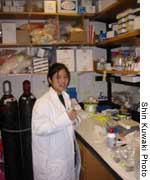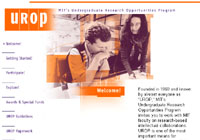Campus life — Letters from MIT
Going beyond the curriculum
By Shin Kuwaki

|
| 白衣に身を包んで、研究中の筆者。 |
Projects are offered in almost every department at the school. Because the majority of students take science majors, most projects tend to involve the sciences. There are, however, some opportunities to undertake UROP projects in other fields such as business and management or politics.
Because the MIT curriculum is very intensive, the UROP provides an opportunity for students to learn about a field of study other than their major. For example, students studying computer science can choose to work in a laboratory for biology, chemistry or media studies so that they can learn to apply their computer skills to these different areas. Projects can also be used for credit, or in some cases, students can be paid for their work.

|
| UROP のサイトhttp://web.mit.edu/urop/index.html。 |
After selecting a project of interest, students contact either the faculty member in charge of the lab or a graduate student working in the lab, who together with a special UROP committee decides whether the student can join.
I have participated in four different UROP projects during my time at MIT. The first one was at the MIT Media Lab, where I worked on constructing 3-D images using computer graphics and making the images into holograms. Every year, the Media Lab attracts many students for their creative, fun, engaging and highly technical research. I have also worked in the fields of chemical engineering and neurobiology as a sophomore. Currently, as a junior, I am working in the field of environmental engineering, studying technology used to detect microscopic organisms in the ocean.
What I like about the program is how it allows students to learn about issues that can never be found in books or classes alone. While working at the Media Lab, I learned a lot about holographic research in laboratories outside MIT, including those in New York and Japan.
In addition to academic issues, it is a great way to develop new friendships and to get to know students from a wide variety of backgrounds. I learned a lot about cultural differences through the people I worked with. During my second UROP project, I worked with many scientists from Malaysia because the project was a collaborative effort with a school in Malaysia. This year, the lab is filled with enthusiastic women from many different countries like Portugal, Croatia, Thailand and Spain. They each add a different flavor to the lab, and they are all important mentors and advisors to me.
The UROP helps to broaden a student's perspective on both cultural and intellectual issues. Many students will continue to participate in the program, which is sure to become one of the highlights of a student's MIT experience.
Shukan ST: Nov. 22, 2002
(C) All rights reserved